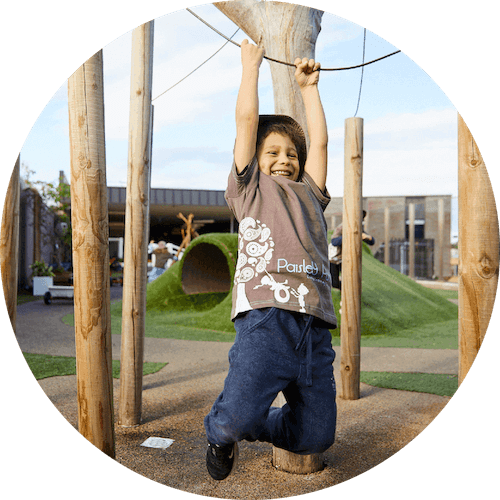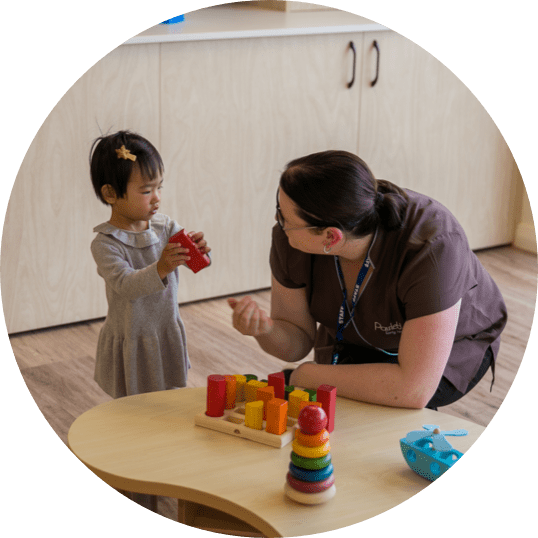
Our Commitment to Quality and Safety Standards
As a parent, you can be assured by our commitment to working in accordance with Australia’s National Quality Framework, Education and Care Regulations and National Principles for Child Safe Organisations.
Our unique Quality Improvement Plan (QIP) Framework is holistic and collaborative and ensures active participation from families, Educators, children and the broader community.
“Our shared responsibility framework embeds an ongoing cycle of quality assurance within our entire organisation and represents our genuine commitment to child safety and continuous improvement.”

Our Approach to Quality and Safety Standards
Our ‘shared responsibility’ framework ensures all stakeholders; including families, Educators, children, specialist services, and relevant government bodies have an opportunity to engage in our quality improvement process.
Monthly Mentor Sessions, Reflective Communities of Practice, Ongoing Family Communication and Family Meetings are designed to unpack each of the seven National Quality Standards and reflect on ways we can identify and address areas for improvement.
The 7 Quality Areas of the National Quality Standard
Educational Program and Practice
Educational program and practice of Educators are child-centred, stimulating and maximise opportunities for enhancing and extending each child’s learning and development.
Children’s Health and Safety
Children have the right to experience quality education and care in an environment that safeguards and promotes their health, safety and wellbeing.
Physical Environment
Physical environment is safe, suitable and provides a rich and diverse range of experiences that promote children’s learning and development.
Staffing Arrangements
Qualified and experienced educators, who develop warm, respectful relationships with children, create predictable environments and encourage children’s active engagement in the learning program.
Relationships with Children
Relationships with children are responsive, respectful and promote children’s sense of security and belonging.
Collaborative Partnerships with Families and Communities
Collaborative relationships with families are fundamental to achieving quality outcomes for children, and community partnerships based on active communication, consultation and collaboration are essential.
Leadership and Service Management
Effective leadership and governance of the service contributes to quality environments for children’s learning and development. Effective leaders establish shared values for the service and set clear direction for the service’s continuous improvement.

Approach to Child Safe Standards
The National Principles for Child Safe Organisations are a set of guidelines aimed at promoting child safety within all organisations that work with children. They were developed to instigate a cultural shift in Australia that prioritises the prevention, response, and reporting of child abuse.
A focus on child safety and wellbeing is embedded in our organisation’s leadership, governance, culture and daily operations. We use the Child Safe Standards to drive a continuous improvement approach to child safe culture. We adopt and adapt strategies and processes that put the interests of children first to keep them safe from harm at all times.
The 11 Child Safe Standards
-

Standard 1
Organisations establish a culturally safe environment in which the diverse and unique identities and experiences of Aboriginal children and young people are respected and valued
-

Standard 2
Child safety and wellbeing is embedded in organisational leadership, governance and culture
-

Standard 3
Children and young people are empowered about their rights, participate in decisions affecting them and are taken seriously
-

Standard 4
Families and communities are informed and involved in promoting child safety and wellbeing
-

Standard 5
Equity is upheld and diverse needs respected in policy and practice
-

Standard 6
People working with children and young people are suitable and supported to reflect child safety and wellbeing values in practice
-

Standard 7
Processes for complaints and concerns are child-focused
-

Standard 8
Staff and volunteers are equipped with the knowledge, skills and awareness to keep children and young people safe through ongoing education and training
-

Standard 9
Physical and online environments promote safety and wellbeing while minimising the opportunity for children and young people to be harmed
-

Standard 10
Implementation of the Child Safe Standards is regularly reviewed and improved
-

Standard 11
Policies and procedures document how the organisation is safe for children and young people

3 Steps to Happier, Healthier,
Confident Children

1. Make an Enquiry
Get in touch with our Enrolments Manager Jo to talk about your childcare options.
Get answers to all your questions and find out everything you want to know about your nearest Paisley Park Early Learning Centre.

2. Book a Tour
Take a personal tour with our Centre Director to see the centre for yourself.
Come and meet the team and get a sense of how things run and how the children interact with each other and their Educators.

3. Enrol Your Child
Once you’ve decided that Paisley Park is the right choice for your family, you’re ready to enrol.
At some centres there is a waitlist and we’ll add you to our priority list for when a place becomes available.



